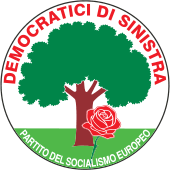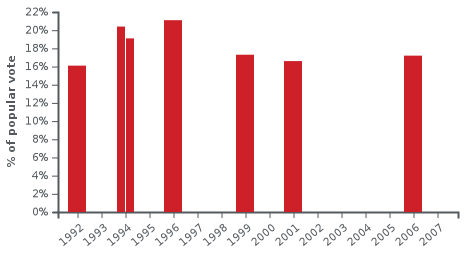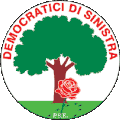Democrats of the Left
The Democrats of the Left (Italian: Democratici di Sinistra, DS) was a social-democratic[2][3][4] political party in Italy.
Democrats of the Left Democratici di Sinistra | |
|---|---|
 | |
| Former Secretaries | Massimo D'Alema Walter Veltroni Piero Fassino |
| President | Massimo D'Alema (1998–2007) |
| Founded | 14 February 1998 |
| Dissolved | 14 October 2007 |
| Preceded by | Democratic Party of the Left |
| Merged into | Democratic Party |
| Headquarters | Via Palermo 12, Rome |
| Youth wing | Young Left |
| Membership (2007) | 615,414[1] |
| Ideology | Social democracy[2][3][4] |
| Political position | Centre-left[5] |
| National affiliation | The Olive Tree (1998–2007) The Union (2005–2007) |
| European affiliation | Party of European Socialists |
| International affiliation | Socialist International |
| European Parliament group | Party of European Socialists |
| Colors | Red |
The DS, successor of the Democratic Party of the Left (PDS) and the Italian Communist Party, was formed in 1998 upon the merger of the PDS with several minor parties. A member of The Olive Tree coalition, in October 2007 the DS merged with Democracy is Freedom – The Daisy and a number of minor centre-left parties to form the Democratic Party.[6]
The DS was successively led by Massimo D'Alema, Walter Veltroni and Piero Fassino.
History
At its 20th congress in 1991, the Italian Communist Party was transformed into the Democratic Party of the Left, responding to the Revolutions of 1989 in eastern Europe by re-orienting the party towards the European democratic-socialist tradition.[7] Under the leadership of Massimo D'Alema, the PDS merged with some minor centre-left movements (Labour Federation, Social Christians, Republican Left, Unitarian Communists, Reformists for Europe and Democratic Federation) on 13 February 1998.[8][9] The DS' symbol lacked the hammer and sickle, which was present in the PDS' one and was instead replaced by the red rose of European social democracy as used by the Party of European Socialists (PES).
Massimo D'Alema became Prime Minister of Italy in October 1998, the first former Communist to hold the post. D'Alema was replaced as the leader of DS by Walter Veltroni. During the party's first national congress in January 2000, Veltroni received the support of the 79.9% of delegates, while the left-wing of the party, at the time led by three women (Anna Finocchiaro, Fulvia Bandoli and Pasqualina Napoletano), had the support of 20.1% of delegates.
Leadership of Piero Fassino
During the party's second national congress in November 2001, Piero Fassino, a mainstream social democrat, was elected secretary with 61.8% of party members' votes. In the event, Giovanni Berlinguer, endorsed by left-wingers, democratic socialists and the Italian General Confederation of Labour (CGIL) trade union, gained 34.1%, while Enrico Morando, from the liberal right-wing, got 4.1%. Contextually, D'Alema was elected president.
During the third national congress in February 2005, Fassino was re-elected with 79.0% of the vote. No-one stood against Fassino, but left-wing candidates ran for congressional delegates: the DS Left-wing – Returning to win motion/list won 14.6% of the vote, DS Left-wing for Socialism 4.0% and the Ecologist Left 2.4%.
2006 general election
In the 2006 general election, the DS endorsed Romano Prodi for Prime Minister and were part of the Olive Tree electoral list, along with Democracy is Freedom – The Daisy (DL) and the European Republicans Movement (MRE), for the Chamber of Deputies, while fielding its own list for the Senate. The DS–DL–MRE joint list obtained 31.2% of the vote and 220 deputies, while the DS list 17.2% and 62 senators. The party's dismal result and the razor-thin win of The Union coalition over the centre-right House of Freedoms coalition prompted a discussion on the party's future. By the end of 2006 the party leadership was committed to a merger with DL.
Nine Ministers of the Prodi II Cabinet were affiliated to the DS, notably including D'Alema who served as Deputy Prime Minister and Minister of Foreign Affairs. Giorgio Napolitano, another DS member, was elected President of Italy in May 2006.
Fourth national congress and split
The party's fourth national congress was held in 19–21 April 2007: During local congresses, Fassino and his motion named For the Democratic Party, backed by most leading members (D'Alema, Pier Luigi Bersani, Antonio Bassolino, etc.), received the support of 75.6% by party members.[10] The left-wing of Fabio Mussi, Cesare Salvi, Fulvia Bandoli and Valdo Spini (To the Left. For European Socialism) scored 15.0%; this motion was instead opposed to the merger of the DS with DL.[10] A third motion (For a New, Democratic and Socialist Party), signed by Gavino Angius, Mauro Zani and originally Giuseppe Caldarola, took 9.3% of the vote: its members (gathered in the new Socialists and Europeans faction) supported the creation of a new party only within the PES, which was opposed by DL.[10]
As a result, the DS approved the formation of a "Democratic Party", along with DL and minor parties. Most supporters of the two motions which had opposed the merger left the DS right after the congress and launched the Democratic Left on 5 May 2007, which aimed to unite the heterogeneous Italian left-wing.[10]
The Democratic Party (PD) was formed in October 2007 and its first secretary was Walter Veltroni, a former DS leader who was elected leader of the new party through a leadership election, which saw the participation of over 3,.5 million Italian voters in which Veltroni won 75.8% of the vote.
Factions
Inside the DS, there was often a somewhat simplistic distinction between reformists (riformisti) and radicals (radicali), indicating respectively the party's mainstream and its left-wing. The party also included several organised factions.
The social-democratic majority was loosely organised, while including several organised movements: the Labourites – Liberal Socialists, Reformist Europe and the Sicilian "Reformist Movement", all three splinter groups of the Italian Socialist Party; the Social Christians, which had emerged from the left-wing of Christian Democracy; the Republican Left, from the left-wing of the Italian Republican Party; and the Liberal Left, from the left-wing of the Italian Liberal Party. A dissident group left the Labourites in order to launch Socialists and Europeans as a vehicle to oppose the party's merger with DL.
On the party's right, the Liberal DS had a moderate Third Way or radical-centrist political agenda and joined the party's majority in latter years.
Before the party's last congress in 2007, the left-wing opposition was led by the DS Left-wing – Returning to win, a democratic-socialist grouping, with other smaller groups including DS Left – wing for Socialism and the Ecologist Left.
Before that, some DS leading members, including Pietro Ingrao, Achille Occhetto and Pietro Folena, had left the party in order to join the Communist Refoundation Party which, at its sixth congress, held in January 2005, moved toward a more heterogeneous, non-sectarian and strongly pacifist variety of leftism.
Popular support
The electoral results of DS (PDS until 1998) in general (Chamber of Deputies) and European Parliament elections from 1992 to 2006 are shown in chart below. The result for the 2006 general election refers to the election for the Senate (the DS contested the election for the Chamber of Deputies in a joint list with DL).

The electoral results of the DS (PDS until 1998) in the 10 most populated regions of Italy are shown in the table below.
| 1994 general | 1995 regional | 1996 general | 1999 European | 2000 regional | 2001 general | 2004 European | 2005 regional | 2006 general | |
| Piedmont | 16.7 | 21.7 | 16.9 | 13.7 | 17.7 | 15.9 | with Ulivo | 20.1 | 16.9 |
| Lombardy | 13.0 | 16.5 | 15.1 | 12.9 | with Ulivo | 11.7 | with Ulivo | with Ulivo | 12.4 |
| Veneto | 12.2 | 16.5 | 11.8 | 11.1 | 12.3 | 10.7 | with Ulivo | with Ulivo | 11.5 |
| Emilia-Romagna | 36.6 | 43.0 | 35.7 | 32.8 | 36.2 | 28.8 | with Ulivo | with Ulivo | 30.6 |
| Tuscany | 33.7 | 40.9 | 34.8 | 31.9 | 36.4 | 30.9 | with Ulivo | with Ulivo | 29.8 |
| Lazio | 23.3 | 27.2 | 23.5 | 18.4 | 20.0 | 17.3 | with Ulivo | with Ulivo | 19.2 |
| Campania | 19.7 | 19.5 | 20.0 | 13.8 | 14.2 | 14.3 | with Ulivo | 15.3 | 14.1 |
| Apulia | 19.9 | 22.1 | 22.1 | 14.1 | 15.7 | 12.9 | with Ulivo | 16.6 | 15.6 |
| Calabria | 22.2 | 22.2 | 21.0 | 16.4 | 14.3 | 17.9 | with Ulivo | 15.4 | 14.4 |
| Sicily | 16.5 | 14.1 (1996) | 16.6 | 12.0 | 10.1 (2001) | 10.3 | with Ulivo | 14.0 (2006) | 11.4 |
Electoral results
Italian Parliament
| Chamber of Deputies | |||||
| Election year | Votes | % | Seats | +/− | Leader |
|---|---|---|---|---|---|
| 2001 | 6,151,154 (2nd) | 16.6 | 137 / 630 |
||
| 2006 | with Ulivo | – | 123 / 630 |
||
| Senate of the Republic | |||||
| Election year | Votes | % | Seats | +/− | Leader |
|---|---|---|---|---|---|
| 2001 | with Ulivo | – | 64 / 315 |
||
| 2006 | 5,977,347 (2nd) | 17.5 | 62 / 315 |
||
European Parliament
| European Parliament | |||||
| Election year | Votes | % | Seats | +/− | Leader |
|---|---|---|---|---|---|
| 1999 | 5,387,729 (2nd) | 17.3 | 15 / 87 |
||
| 2004 | with Ulivo | – | 12 / 78 |
||
Symbols
 1998
1998 2004
2004
Leadership
- Secretary: Massimo D'Alema (1998), Walter Veltroni (1998–2001), Piero Fassino (2001–2007)
- Coordinator: Marco Minniti (1998), Pietro Folena (1998–2001), Vannino Chiti (2001–2004), Vannino Chiti / Maurizio Migliavacca (2004–2006), Maurizio Migliavacca (2006–2007)
- Organizational Secretary: Pietro Folena (1998), Franco Passuello (1998–2001), Maurizio Migliavacca (2001–2004), Marina Sereni (2004–2006), Andrea Orlando (2006–2007)
- President: Massimo D'Alema (2000–2007)
- Party Leader in the Chamber of Deputies: Fabio Mussi (1998–2001), Luciano Violante (2001–2006), Marina Sereni (deputy-leader of the Olive Tree's group, 2006–2007)
- Party Leader in the Senate: Gavino Angius (1998–2006), Anna Finocchiaro (leader of the Olive Tree's group, 2006–2007)
- Party Leader in the European Parliament: Renzo Imbeni (1998–1999), Pasqualina Napoletano (1999–2004), Nicola Zingaretti (2004–2006), Giovanni Pittella (2006–2009)
References
- Ds: Tutti i numeri del quarto congresso, "Corriere della Sera", 19 April 2007.
- André Krouwel (2012). Party Transformations in European Democracies. SUNY Press. p. 333. ISBN 978-1-4384-4483-3. Retrieved 14 February 2013.
- Marcus E. Ethridge; Howard Handelman (2009). Politics in a Changing World: A Comparative Introduction to Political Science. Cengage Learning. p. 157. ISBN 978-0-495-57048-6. Retrieved 17 August 2012.
- Donald F. Busky (2002). Communism in History and Theory: The European Experience. Greenwood Publishing Group. p. 57. ISBN 978-0-275-97734-4. Retrieved 24 August 2012.
- Pietro Castelli Gattinara (2016). "Appendix 2". The Politics of Migration in Italy: Perspectives on Local Debates and Party Competition. Routledge. p. 192. ISBN 978-1-317-24174-4.
- Donatella M. Viola (2015). "Italy". Routledge Handbook of European Elections. Routledge. p. 116. ISBN 978-1-317-50363-7.
- Daniela Giannetti; Rosa Mulé (2013). "The Democratici di Sinistra: In Search of a New Identity". In Anna Bosco; Leonardo Morlino (eds.). Party Change in Southern Europe. Routledge. p. 123. ISBN 978-1-136-76777-7.
- Donatella M. Viola (2015). "Italy". Routledge Handbook of European Elections. Routledge. p. 126. ISBN 978-1-317-50363-7.
- Daniela Giannetti; Michael Laver (2008). "Party cohesion, party discipline, and party factions in Europe". In Daniela Giannetti; Kenneth Benoit (eds.). Intra-Party Politics and Coalition Governments. Routledge. p. 152. ISBN 978-1-134-04288-3.
- Daniela Giannetti; Michael Laver (2008). "Party cohesion, party discipline, and party factions in Italy". In Daniela Giannetti; Kenneth Benoit (eds.). Intra-Party Politics and Coalition Governments. Routledge. p. 154. ISBN 978-1-134-04288-3.